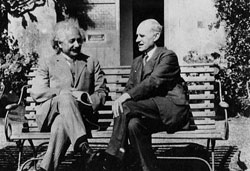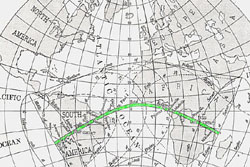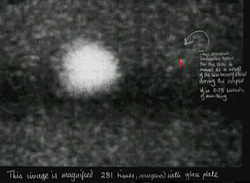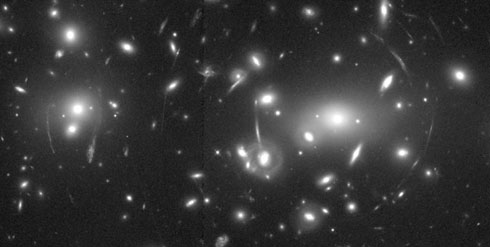The story of how a British scientist
used an eclipse to provide the evidence for Einstein's theory of general
relativity.
by Peter Coles
A total eclipse of
the Sun is a moment of magic: a scant few minutes when our perceptions
of the whole Universe are turned on their heads. The Sun’s
blinding disc is replaced by ghostly pale tentacles surrounding
a black heart – an eerie experience witnessed by hundreds of
millions of people throughout Europe and the Near East last August.
But one particular
eclipse of the Sun, eighty years ago, challenged not only people’s
emotional world. It was set to turn the science of the Universe
on its head. For over two centuries, scientists had believed Sir
Isaac Newton’s view of the Universe. Now his ideas had been
challenged by a young German-Swiss scientist, called Albert Einstein.
The showdown - Newton vs Einstein – would be the total
eclipse of 29 May 1919.
Newton’s position
was set out in his monumental Philosophiae Naturalis Principia
Mathematica, published in 1687. The Principia –
as it’s familiarly known - laid down a set of mathematical
laws that described all forms of motion in the Universe. These rules
applied as much to the motion of planets around the Sun as to more
mundane objects like apples falling from trees.
At the heart of Newton’s
concept of the Universe were his ideas about space and time. Space
was inflexible, laid out in a way that had been described by the
ancient Greek mathematician Euclid in his laws of geometry. To Newton,
space was the immovable and unyielding stage on which bodies acted
out their motions. Time was also absolute, ticking away inexorably
at the same rate for everyone in the Universe.

Sir Isaac Newton by Sir Godfrey Kneller
Courtesy of the National Portrait Gallery, London
Sir
Isaac Newton proposed the first theory of gravity.
|
For over 200 years, scientists saw the
Cosmos through Newton’s eyes. It was a vast clockwork machine,
evolving by predetermined rules through regular space, against the
beat of an absolute clock. This edifice totally dominated scientific
thought, until it was challenged by Albert Einstein.
In 1905, Einstein dispensed
with Newton’s absolute nature of space and time. Although born
in Germany, during this period of his life he was working as a patent
clerk in Berne, Switzerland. He encapsulated his new ideas on motion,
space and time in his special theory of relativity. But it took
another ten years for Einstein to work out the full consequences
of his ideas, including gravity. The general theory of relativity,
first aired in 1915, was as complete a description of motion as
Newton had prescribed in his Principia. But Einstein’s
description of gravity required space to be curved. Whereas
for Newton space was an inflexible backdrop, for Einstein it had
to bend and flex near massive bodies. This warping of space, in
turn, would be responsible for guiding objects such as planets along
their orbits.

Royal Observatory Greenwich
Albert
Einstein and Arthur Eddington: the father of relativity
and the man who proved him right.
|
By the time he developed
his general theory, Einstein was back in Germany, working in Berlin.
But a copy of his general theory of relativity was soon smuggled
through war-torn Europe to Cambridge. There it was read by Arthur
Stanley Eddington, Britain’s leading astrophysicist. Eddington
realised that Einstein’s theory could be tested. If space really
was distorted by gravity, then light passing through it would not
travel in a straight line, but would follow a curved path. The stronger
the force of gravity, the more the light would be bent. The bending
would be largest for light passing very close to a very massive
body, such as the Sun.
Unfortunately, the
most massive objects known to astronomers at the time were also
very bright. This was before black holes were seriously considered,
and stars provided the strongest gravitational fields known. The
Sun was particularly useful, being a star right on our doorstep.
But it is impossible to see how the light from faint background
stars might be bent by the Sun’s gravity, because the Sun’s
light is so bright it completely swamps the light from objects beyond
it.

Royal Observatory Greenwich
Scientist's
sketch of the path of the vital 1919 eclipse.
|
Eddington realised
the solution. Observe during a total eclipse, when the Sun’s
light is blotted out for a few minutes, and you can see distant
stars that appear close to the Sun in the sky. If Einstein was right,
the Sun’s gravity would shift these stars to slightly different
positions, compared to where they are seen in the night sky at other
times of the year when the Sun far away from them. The closer the
star appears to the Sun during totality, the bigger the shift would
be.
Eddington began to
put pressure on the British scientific establishment to organise
an experiment. The Astronomer Royal of the time, Sir Frank Watson
Dyson, realised that the 1919 eclipse was ideal. Not only was totality
unusually long (around six minutes, compared with the two minutes
we experienced in 1999) but during totality the Sun would be right
in front of the Hyades, a cluster of bright stars.
But at this point the
story took a twist. Eddington was a Quaker and, as such, a pacifist.
In 1917, after disastrous losses during the Somme offensive, the
British government introduced conscription to the armed forces.
Eddington refused the draft and was threatened with imprisonment.
In the end, Dyson’s intervention was crucial persuading the
government to spare Eddington. His conscription was postponed under
the condition that, if the war had finished by 1919, Eddington himself
would lead an expedition to measure the bending of light by the
Sun. The rest, as they say, is history.
The path of totality
of the 1919 eclipse passed from northern Brazil, across the Atlantic
Ocean to West Africa. In case of bad weather (amongst other reasons)
two expeditions were organised: one to Sobral, in Brazil, and the
other to the island of Principe, in the Gulf of Guinea close to
the West African coast. Eddington himself went to Principe; the
expedition to Sobral was led by Andrew Crommelin from the Royal
Observatory at Greenwich.

Royal Observatory Greenwich
British
scientists in the field at Sobral in 1919.
|
The expeditions did
not go entirely according to plan. When the day of the eclipse (29
May) dawned on Principe, Eddington was greeted with a thunderstorm
and torrential rain. By mid-afternoon the skies had partly cleared
and he took some pictures through cloud.
Meanwhile, at Sobral,
Crommelin had much better weather - but he had made serious errors
in setting up his equipment. He focused his main telescope the night
before the eclipse, but did not allow for the distortions that would
take place as the temperature climbed during the day. Luckily, he
had taken a backup telescope along, and this in the end provided
the best results of all.
After the eclipse,
Eddington himself carefully measured the positions of the stars
that appeared near the Sun’s eclipsed image, on the photographic
plates exposed at both Sobral and Principe. He then compared them
with reference positions taken previously when the Hyades were visible
in the night sky. The measurements had to be incredibly accurate,
not only because the expected deflections were small. The images
of the stars were also quite blurred, because of problems with the
telescopes and because they were seen through the light of the Sun’s
glowing atmosphere, the solar corona.
Before long the results
were ready. Britain’s premier scientific body, the Royal Society,
called a special meeting in London on 6 November. Dyson, as Astronomer
Royal took the floor, and announced that the measurements did not
support Newton’s long-accepted theory of gravity. Instead,
they agreed with the predictions of Einstein’s new theory.

Royal Observatory Greenwich
The
final proof: the small red line shows how far the position
of the star has been shifted by the Sun’s gravity.
|
The press reaction
was extraordinary. Einstein was immediately propelled onto the front
pages of the world’s media and, almost overnight, became a
household name. There was more to this than purely the scientific
content of his theory. After years of war, the public embraced a
moment that moved mankind from the horrors of destruction to the
sublimity of the human mind laying bare the secrets of the Cosmos.
The two pacifists in the limelight - the British Eddington and the
German-born Einstein - were particularly pleased at the reconciliation
between their nations brought about by the results.
But the popular perception
of the eclipse results differed quite significantly from the way
they were viewed in the scientific establishment. Physicists of
the day were justifiably cautious. Eddington had needed to make
significant corrections to some of the measurements, for various
technical reasons, and in the end decided to leave some of the Sobral
data out of the calculation entirely. Many scientists were suspicious
that he had cooked the books. Although the suspicion lingered for
years in some quarters, in the end the results were confirmed at
eclipse after eclipse with higher and higher precision.

NASA In
this cosmic ‘gravitational lens,’ a huge cluster
of galaxies distorts the light from more distant galaxies
into a pattern of giant arcs.
|
Nowadays astronomers
are so confident of Einstein’s theory that they rely on the
bending of light by gravity to make telescopes almost as big as
the Universe. When the conditions are right, gravity can shift an
object’s position by far more than a microscopic amount. The
ideal situation is when we look far out into space, and centre our
view not on an individual star like the Sun, but on a cluster of
hundreds of galaxies – with a total mass of perhaps 100 million
million suns. The space-curvature of this immense ‘gravitational
lens’ can gather the light from more remote objects, and focus
them into brilliant curved arcs in the sky. From the size of the
arcs, astronomers can ‘weigh’ the cluster of galaxies.
Einstein didn’t
live long enough to see through a gravitational lens, but if he
had he would definitely have approved.
